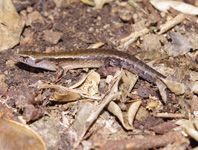Abstract
We describe a new species of the genus Hemiphyllodactylus on the basis of four specimens from Cao Bang Province, northern Vietnam. Hemiphyllodactylus zugi sp. nov. is distinguished from the remaining congeners by a combination of the following characters: a bisexual taxon; average SVL of adult males 41 mm, of adult female 46.6 mm; chin scales bordering mental and first infralabial distinctly enlarged; digital lamellae formulae 3-4-4-4 (forefoot) and 4-5-5-5 (hindfoot); femoral and precloacal pore series continuous, 18–21 in total in males, absent in female; cloacal spur single in males; dorsal trunk pattern of dark brown irregular transverse bands; dark lateral head stripe indistinct; upper zone of flank with a series of large light spots, edged above and below in dark grey; caecum and gonadal ducts unpigmented.

